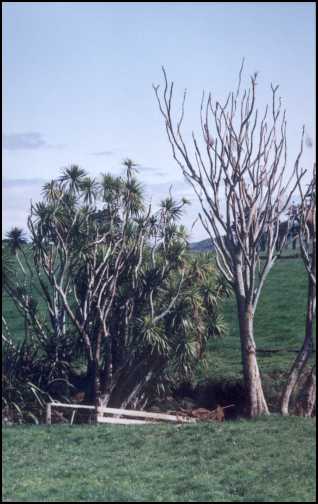Breakthrough in cabbage tree mystery

Breakthrough in cabbage tree mystery
Landcare Research has made some major advancements in understanding the sudden decline disease of our iconic native cabbage tree (Cordyline australis), also known as ti kouka. Cabbage trees have succumbed in large numbers to the disease, which causes the leaves to yellow and fall off, usually followed by the death of the tree three to 12 months later. In some areas, particularly in the north, no big trees are left.
Landcare Research and HortResearch scientists used highly sensitive DNA techniques and electron microscopy to identify the cause of the disease as a phytoplasma (Phytoplasma australiense), an elusive type of bacterium that lives in plant sap. Their results, from more than a decade of highly specialised scientific work, will soon be published in the prestigious international journal, 'Plant Disease'. This indicates the formal acceptance by the science community of the role of the phytoplasma, which had been hotly debated in the past.
Landcare Research plant pathologist and ecologist, Dr Ross Beever, says the research team gradually ruled out hypotheses including tree aging, fungi, viruses, and environmental factors such as enhanced UV, particularly as healthy trees could often be found next to dying ones. While typical plant disease-causing bacteria were not found, the phytoplasma was. These highly specialised bacteria cannot be grown in lab culture and can cause disease even when they are present in very low numbers in the plant. "Seeing the phytoplasma under the electron microscope was like finding a needle in a haystack" says Dr Beever.
Dr Beever says DNA techniques indicate that the phytoplasma is native to New Zealand flax, and has spread to other species. The pathogen caused massive epidemics of yellow leaf disease in flax early last century, destroying the once extensive flax swamps of Manawatu and was a major factor leading to the eventual collapse of the once flourishing flax fibre industry. Dr Beever says as well as spreading to the cabbage tree, this microscopic pest affects the health of other native species, particularly karamu (Coprosma robusta).
It is also suspected to cause dieback and death of the black tree fern, mamaku (Cyathea medullaris); kohuhu (Pittosporum tenufolium) and puriri (Vitex lucens). The phytoplasma has also been found in strawberries in New Zealand, and in Australia, it is linked with diseases of grape and papaya.
Dr Beever says although the cabbage tree pathogen has been identified, many questions still need to be answered. "The next major aim of the research is to identify the plant-hopping insect or insects that spread the phytoplasma. This knowledge is important for devising methods for managing the disease long-term.
"We also need a clearer picture of what plant species are affected by the pathogen, and how. Do the insect vectors move the phytoplasma from the cabbage tree to other species? Does the pathogen affect commercial crops other than strawberry? Are there symptomless carriers of the phytoplasma? Are there natural sources of resistance? And is there is some way of repelling the insect vectors?"
While the research is on-going, Dr Beever says it has identified things that people can do to increase the survival of cabbage trees in the short term. " I encourage rural landowners to fence off existing cabbage tree patches, to keep them clear of grazing stock, and thus allow natural regeneration to occur. Planting cabbage trees in gardens and land restoration projects will also play an important role in maintaining cabbage trees as a special feature of our landscape."
ENDS
For more information, contact: Dr Ross Beever Landcare Research Mt Albert wk (09) 815 4200 EXT 7310 email: BeeverR@landcare.cri.nz
ENDS


 Bill Bennett: Comcom warns 2degrees over satellite marketing
Bill Bennett: Comcom warns 2degrees over satellite marketing Transpower: Major Electricity Development For Western Bay Of Plenty A Step Closer
Transpower: Major Electricity Development For Western Bay Of Plenty A Step Closer Alcohol Beverages Council: Turning The Tide - New Zealanders Unite To Curb Harmful Drinking
Alcohol Beverages Council: Turning The Tide - New Zealanders Unite To Curb Harmful Drinking University of Auckland Business School: Economists Urge Action To Prevent ‘AI Poverty Traps’
University of Auckland Business School: Economists Urge Action To Prevent ‘AI Poverty Traps’ Bill Bennett: Australian warship takes rural fixed wireless broadband offline
Bill Bennett: Australian warship takes rural fixed wireless broadband offline NZ Telecommunications Forum - TCF: New Zealand Is Saying Goodbye To 3G: Are You Ready For The Change?
NZ Telecommunications Forum - TCF: New Zealand Is Saying Goodbye To 3G: Are You Ready For The Change?


